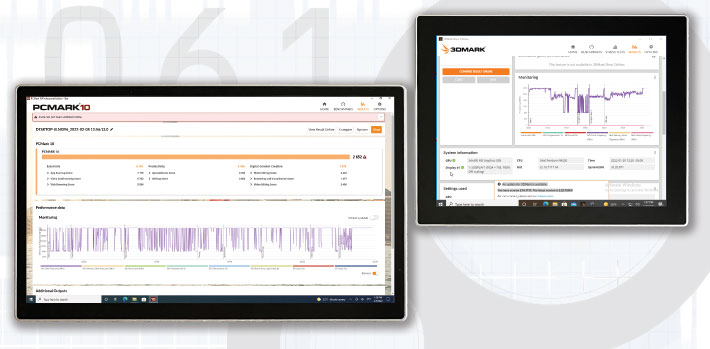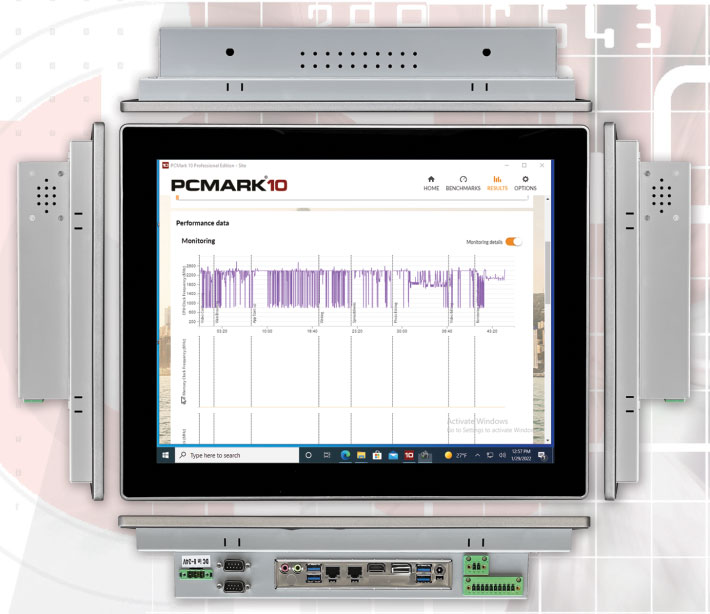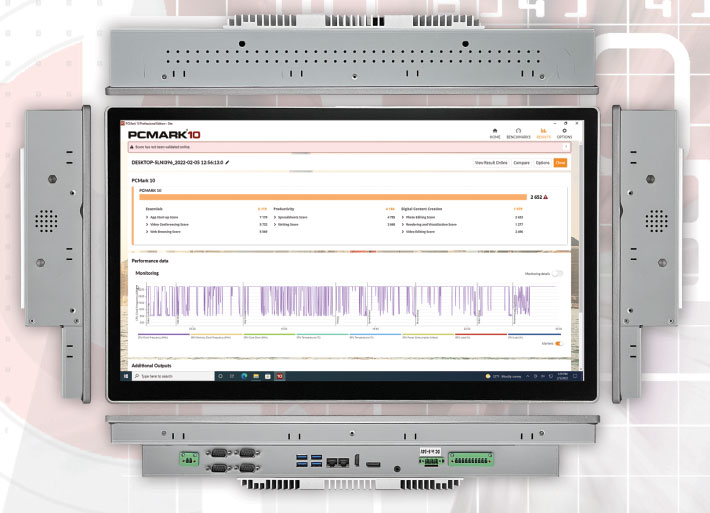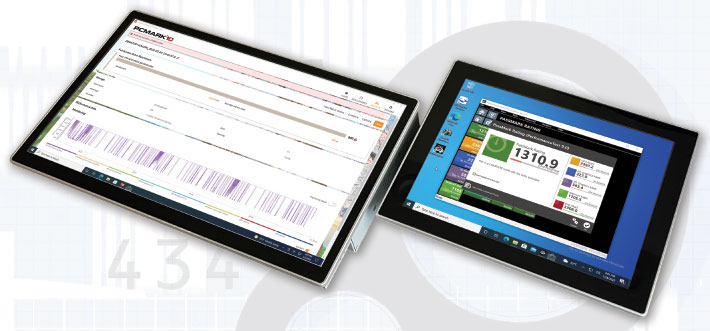|
Teguar Economy Panel PC Series
What you do (and do not) get in a new line of affordable industrial panel computers
(by Conrad H. Blickenstorfer)
Share on:



In this article we'll describe and examine Teguar's Economy Panel PC Series, including benchmarking and a detailed look at two models of the series, the 15-inch TP-3493-15 and the 22-inch TP-5593-22.
Teguar launched this series to address something that rarely comes up in product marketing and isn't usually in spec sheets, yet is an important factor in pretty much every purchase or request for proposal: affordability. That's a big issue in these pandemic times marked by uncertainty, supply chain challenges, component shortages, all with their competing priorities of both efficiency and high degrees of automation, but also affordability and return on investment. Add to that the constant lure of new and emerging technology that comes, however, at a cost, and the harsh realities of budgets and bottom lines. In that light, affordability assumes a meaning that goes beyond hunting for discounts and special deals — what is really needed to get the job done?

And that, Teguar says, is what made them create this series of "economy" panel PCs where low cost doesn't necessarily mean cost-cutting in materials, components and features, but concentrating on the basics needed to get the job done, no more and no less. With that in mind, Teguar decided to forego the modularity and extensive configurability in most of their other series of industrial computers, but not at the expense of value and functionality.
The economy series currently consists of just three models, each different in size and intended purpose. There will likely be more, but for now it's a proof of concept. And despite their differences, each of the trio provides the same set of solid basics: a steel enclosure, industry-standard mounting, a capacitive touch screen, fanless cooling, and I/O covering all the basics.
The picture above shows the two larger models of Teguar's affordable trio of tough and rugged industrial panel PCs, the 15-inch TP-3493-15 and the 22-inch TP-5593-22.
Teguar's affordable Economy Panel PC Series: concept and models
Unlike most of Teguar's series of rugged industrial and medical panel computers and monitors that make available a set of features and functionalities in various display sizes, scalable performance, and modular expansion and configuration, this economy series has just one goal: providing affordable computing power built on a number of basic precepts. Here is what all current and future models in the line share:

- All three have steel enclosures made to provide structural integrity and to withstand harsh environments.
- All models can be panel mounted or attached to a stand or adjustable arm via standard VESA mount.
- All models use a fanless cooling system for silent operation, avoidance of potentially unwanted airflows, and minimal maintenance.
- All models have an IP65-rated front panel.
- All models can operate within a wide operating temperature range
- All models have four USB 3.0, two RJ45 GbE LAN inputs, at least two legacy serial ports, and dual external video.
- All models support wide-range DC power input.
- All models have at least one internal expansion slot.
You generally get what you pay for. Sometimes that works out well and you end up with real bargains. Other times you may later regret for not having paid more for a higher-end product. It all depends. This series is likely an experiment by Teguar, an effort to make value available to their customers IF they can live with the decisions and cost-considerations that go into budget-conscious products.
This report aims to show you what you do and do not get from Teguar with these panel PCs. Spoiler alert: you do get a lot, and a lot of value IF you can live with machines that come as they are rather than being available in many versions with many options and modules and extras.
The table below shows the three Teguar Economy Panel PC Series models currently available.
|
Teguar Economy Panel PC Series models
|
|
Company
|
Teguar
|
Teguar
|
Teguar
|
|
Model
|
TP-4180-10
|
TP-3493-15
|
TP-5593-22
|
|
Screen size
|
10 inches diagonal
|
15 inches diagonal
|
22 inches diagonal
|
|
Screen type
|
Unknown
|
glossy
|
semi-matte
|
|
Screen resolution
|
1280 x 800 pixel
|
1024 x 768 pixel
|
1920 x 1080 pixel
|
|
Screen pixel per inch
|
151 ppi
|
85 ppi
|
100 ppi
|
|
Screen aspect ratio
|
16 : 10
|
4 : 3
|
16 : 9
|
|
Screen luminance
|
300 nits
|
300 nits (282 nits measured)
|
250 nits (345 nits measured)
|
|
Touch
|
Projective Capacitive
|
Projective Capacitive
|
Projective Capacitive
|
|
CPU
|
Intel Celeron J3455 (Apollo Lake)
|
Intel Pentium N4200 (Apollo Lake)
|
Intel Core i3-7100U (Kaby Lake)
|
|
CPU Cores/Threads
|
4/4
|
4/4
|
2/4
|
|
Thermal Design Power
|
10 watts
|
6 watts
|
15 watts
|
|
CPU Speed
|
1.5GHz
|
1.1GHz
|
2.4GHz
|
|
RAM
|
4GB to 16GB in one DDR4 SO-DIMM
|
4GB or 8GB in two DDR2 SO-DIMM
|
4GB to 32GB in two DDR4 SO-DIMM
|
|
Cooling
|
Passive fanless
|
Passive fanless
|
Passive fanless
|
|
Storage type
|
1.8" half-size MO297 SATA Drive Bay, mSATA
|
1 x 2.5" SATA Drive Bay for SSD/HDD
1 x M.2 SATA3 2280 Slot
|
1 x 2.5" SATA Drive Bay for SSD/HDD
|
|
Storage support
|
64GB to 256GB
|
64GB to 512GB
|
64GB to 512GB
|
|
Serial
|
4 x COM RS-232
|
2 x COM RS-232
|
4 x COM RS-232
|
|
Digital I/O
|
NA
|
1 x 8-bit GPIO Terminal Block
|
1 x 8-bit GPIO Terminal Block
|
|
Expansion internal
|
1 x mPCIe
|
1 x M.2 Type E, 1 x M.2 Type B
|
1 x mPCIe, 1 x M.2 Type E
|
|
Expansion external
|
1 x microSD slot
|
NA
|
NA
|
|
USB
|
4 x USB 3.0
|
4 x USB 3.0
|
4 x USB 3.0
|
|
LAN
|
2 x RJ45 GbE
|
2 x RJ45 GbE
|
2 x RJ45 GbE
|
|
HDMI
|
None
|
1 x HDMI
|
1 x HDMI
|
|
DisplayPort
|
2 x DisplayPort
|
1 x DisplayPort
|
1 x DisplayPort
|
|
Speakers
|
2 x 1-watt
|
2 x 2-watt
|
2 x 2-watt
|
|
IP rating
|
IP65 front bezel
|
IP65 front bezel
|
IP65 front bezel
|
|
Operating temp.
|
-10°C to 50°C
(14°F to 122°F)
|
-20°C to 60°C
(-4°F to 140°F)
|
0°C to 50°C
(32°F to 122°F)
|
|
Enclosure
|
Aluminum
|
Aluminum
|
Aluminum
|
|
Size
|
10.9 x 7.2 x 2.4 inches
|
14.2 x 11.1 x 2.6 inches
|
20.0 x 12.1 x 3.3
|
|
Weight
|
7.9 lbs (3.6 kg)
|
9.5 lbs (4.3 kg)
|
17.6 lbs (8.0 kg)
|
|
Power
|
DC 9~36V
|
DC 8~24V
|
DC 8~24V
|
|
Product pages
|
Teguar TP-4180-10
|
Teguar TP-3493-15
|
Teguar TP-5593-22
|
|
Price
|
starting at $760
|
starting at $1,063
|
starting at $1,701
|
The above table nicely illustrates Teguar's idea behind their new affordable panel PC series: it's not about processors or maximum configurability or modularity. It's not about look or design or common technology or features. It's about affordable solutions in various display sizes and adhering to a number of core principles.
Each of the three models has a display of not only different size, but also different resolution, different aspect ratio, and even different surface treatment. What the displays have in common is high enough luminance for indoor and limited outdoor use and, of course, the by now ubiquitous capacitive touch interface. All use passive cooling, which eliminates the noise, potentially disruptive air flow and potential point of failure of a fan.
Both RAM and mass storage are, within limits, configurable. Mass storage uses inexpensive and widely available SATA-based solid state or hard disks. Here again it's affordability over costlier solutions.
Internal expandability and configurability is limited but it's there in the form of M.2 and/or mPCIe sockets. Four USB 3.0, dual RJ45 LAN jacks and at least two COM ports cover many applications' needs. The two larger models also offer an 8-bit GPIO terminal block. All have small but serviceable dual speakers.
Now let's take a closer look at the two sample units Teguar sent RuggedPCReview.com for evaluation.
Teguar TP-3493-15 — 15-inch
The TP-3493-15 is the mid-range product in the Economy Panel PC series. It's a general-purpose rugged panel computer with a very wide range of potential applications. And starting at US$1,063, it costs less than a reasonably equipped iPhone.
The TP-3493-15 measures 14.2 x 11.1 x 2.6 inches and — despite its all-metal construction, weighs under 10 pounds. That's just a third of what the original Compaq portable computer weighed, despite the fact that this Tequar panel is an industrial-grade heavy-duty machine.
The first impression of any of the Teguar Economy Panel PC series anyone will get is how incredibly solid these panel computers feel and are. They look like they're crafted from a solid block of steel. That's, of course, not the case, but it's how substantial they feel. Economy series panels may be affordable and built to a price, but they certainly don't feel cheap in any way. From the looks and feel of it, the housings are made from something like 16 gauge steel (roughly 1.5mm), which is quite a bit thicker than auto body sheet metal. The housings use a box-and-cover design, with the front box about an inch thick, and the back that encloses the electronics adding another inch and a half.

Despite the fanless design, there is no need for a finned cooling sink in this panel; the steel housing alone can easily dissipate all the heat generated by the computer. As is usually the case with industrial panel PCs, all I/O is in the back and faces down. What we especially like is how clearly marked all the ports are.
Opening up the TP-3493-15 is easy. Just undo 14 Phillips screws and the back lifts right off. There are wires between it and the main part of the panel, but they are all long enough for easy work inside without disconnecting any of them. There is no seal between the main box and the back cover. While the front of the panel carries IP65 sealing (and has a rubber o-ring to seal the panel's bezel against its mounting box/kiosk/wall), the back part has openings and does not carry an ingress protection rating (which is the norm for most industrial panels).
With the back cover removed, you see that it is actually mounted onto a second back cover, that one protecting the LCD display and touch panel electronics. Teguar certainly didn't skimp here: this is one tough box.
Underneath the cover, things are quite roomy. There's the roughly 6-1/2 x 6-1/2 inch motherboard. It is dominated by a massive aluminum block that acts as a heatsink and then dissipates the heat via a thermal pad to the exterior case. Everything is easily accessible, way easier, actually, than in a desktop PC. So no fumbling with a flashlight when, for example, changing jumpers on the motherboard.
The system's two 204-pin RAM sockets, likewise, are in plain sight. Our review unit was equipped with two 4GB DDR3-1600 RAM modules (8GB is the processor-mandated hard limit). There are two M.2 slots, one a 2280 B-key (the 80 is stands for 80mm long) that can be used for a SATA SSD, and the other a 2230 E-Key with PCIex1 and USB 2.0 signals for wireless use. The board also has some unused connectors (PCI Express X1, SATA 7-pin, a legacy I/O header, etc) that could possibly be put to use.
Access to everything is simple and easy, and all internal cable connections have their individual wires neatly encased in sleeves, just the way we like to see it. The unit's internal (Transcend) solid state disk drive is firmly rubber-mounted to the chassis with four screws.
Below is a look at the TP-3493-15's down-facing I/O that's remarkably complete for an economy type of machine. Four USB 3.0 ports, dual LAN jacks, audio in and out, HDMI, DisplayPort, dual legacy COM ports, remote on/off and even GPIO. Labeling for each connector is on a very solid insert. DisplayPort and HDMI may well come in handy in applications that require additional/supplementary high-res (up to 4k) displays.

Overall, the TP-3493-15 is a compelling offering both inside and out. In the back, there's the very strong steel frame that provides exceptional structural integrity. The front with its all-glass, 7H scratch-resistant flat touch panel set into an aluminum frame/bezel is IP65-sealed. Its 1024 x 768 pixel resolution has long been the standard for all sorts of HMI and industrial automation machinery. Its 300 nits luminance (282 nits in our testing) is brighter than most consumer laptops.
Teguar TP-5593-22 — 22-inch
The TP-5593-22 is the largest model in the affordable series. With its full HD 1920 x 1080 pixel 16:9 wide-screen aspect ratio this panel offers the sleekest and most modern look of the trio. Suitable as a robust, flexible All-In-One computer, the TP-5593-22, which starts at US$1,700, can be deployed wall- or panel-mounted but also with an articulating arm, adjustable stand, or as a vehicle mount. It is an industrial grade PC with general-purpose desktop computing functionality. With a frontal measurement of 20.0 x 12.1 inches (less than that of a 21.5-inch Apple iMac), the TP-5593-22 is 3.3 inches deep and weighs a manageable 17.6 pounds.

While the TP-5593-22 very much looks like a modern desktop All-In-One from the front, its construction is all industrial-grade. The narrow frontal frame and bezel are aluminum, the entire case is steel, and in the back — this being a silent, fanless system — you find a sizable finned aluminum heat spreader. When wall- or cabinet-mounted the front of of the TP-5593-22 fills IP65 ingress protection requirements (fully dust-proof, protected against low-pressure water jets) thanks to an o-ring pressure seal between the back of the bezel frame and the mounting surface.
Opening up the computer for maintenance, configuration or upgrades couldn't be simpler: undo ten small Phillips screws and the frontal steel plate with the LCD lifts off the rear steel box with the electronics. There are just three cables between the front and back, and working on this machine is a piece of cake. It's surprisingly roomy inside, too. The motherboard measures just 5-1/2 x 4 inches, amazingly compact for a powerful and full-fledged Intel Core-based computer.
As in the smaller 15-inch model, the system's two RAM sockets are in plain sight. Our review unit was equipped with two 4GB PC4-2666 RAM modules, with a maximum RAM configuration of 32GB. There are two internal expansion connectors, one an mPCIe and the other an M.2 Type E.
Here, again, access to everything is simple and easy, and all internal cable connections have their individual wires neatly encased in sleeves, just the way it should be. The unit's internal (Transcend) solid state disk drive is firmly rubber-mounted to the chassis with four screws.
Below is a look at the TP-5593-22's down-facing I/O that's very generous for an economy type of machine. There are four USB 3.0 ports, dual LAN jacks, audio in/out, HDMI, DisplayPort, four legacy DB9 COM ports, remote on/off and even GPIO. Labeling for each connector is on a very solid insert. Here, again, note that the DisplayPort and HDMI video outputs may come in very handy in applications that require additional/supplementary high-res (up to 4k) displays.

In summary, the TP-5593-22 offers the big hi-res display and computing power of a desktop All-In-One in an affordable industrial grade package with numerous applications. Its robust steel/aluminum construction can take a beating, its fanless design means no silent operation and no unwanted airflows, and its 1920 x 1080 pixel resolution is high enough for complex applications. With a measured 345 nits luminance the display is quite bright and it also has good anti-glare and anti-reflection properties.
Computing performance
When it comes to computing performance, more is generally better. Users like instant response, fast completion of tasks, and knowing their systems won't become unbearably slow after a couple of years' worth of software updates. However, higher performance always comes at a price, and in industrial computers it is often not necessary to buy more than what is needed nor always be at the very latest processor generation.
Why would many industrial computers get by with less performance than your standard home or business PC? Because home and business PCs are general purpose computers that must be ready to tackle whatever comes their way, and that might include very complex software. Industrial computers, on the other hand, almost always execute clearly defined tasks that require so and so much computing power, and anything more would simply go to waste.
How does this apply to Teguar's choice of processors for their trio of economy industrial panel PCs? Probably by the company picking the least expensive processor that gets the tasks a model is generally used for done. In this lineup, the two smaller models with their 10-inch and 15-inch screens will most likely be used for human-machine-interface operation. That doesn't require much processing power. And so those two models use lower level processors from Intel's Atom-based lineup.
The big 22-inch panel, on the other hand, may well be used for more compute-intensive tasks, and so that one gets one of Intel's higher level Core processors. Yes, when you look at the spec sheets, both of the lower level chips have four processing cores whereas the higher-level chip in the TP-5593-22 only has two, but those two are far more complex ones. And that's why Intel charges almost ten times as much for the Core i3-7100U processor in the 22-inch panel than it asks for the Celeron J3455 chip in the 10-inch panel.
Both the Celeron J3455 used in the TP-4180-10 and the Pentium N4200 inside the TP-3493-15 are "Apollo Lake" processors designed to idle along at a thermally efficient base frequencies, but also to be capable of operating at significantly burst frequencies to quickly handle heavier loads. The difference between those two is fairly small, pretty much limited to the N4200 having slightly better specs in a number of areas. The Core i3-7100U in the TP-5593-22 is an altogether more powerful chip with significantly higher specs, even though it does not have a turbo mode like higher-level i5 and i7 processors.
To provide an idea of the relative performance of Teguar's Teguar Economy PPC Series performance we ran all of our standard benchmark suites and the results are in the table below. For comparison we added a couple of other Teguar products we recently reviewed, the TP-3445-16 panel mount and the TRT-5280-12 rugged tablet PC. Here are the results:
|
Teguar Economy PPC performance in comparison
|
|
PERFORMANCE COMPARISON
|
Teguar
|
Teguar
|
Teguar
|
Teguar
|
|
Model
|
TP-3493-15
|
TP-5593-22
|
TP-3445-16
|
TRT-5280-12
|
|
|

|

|

|

|
|
Model
|
15-inch Panel PC
|
22-inch Panel PC
|
16-inch Panel PC
|
12-inch Tablet PC
|
|
Year tested
|
2022
|
2022
|
2021
|
2021
|
|
Processor
|
Intel Pentium
|
Intel Core
|
Intel Pentium
|
Intel Core
|
|
Processor Model
|
N4200
|
i3-7100U
|
N4200
|
i7-8550
|
|
Processor Code
|
Apollo Lake
|
Kaby Lake
|
Apollo Lake
|
Kaby Lake R
|
|
CPU Speed
|
1.10GHz
|
2.40GHz
|
1.10GHz
|
1.80GHz
|
|
Turbo Speed
|
2.50GHz
|
no turbo
|
2.50GHz
|
4.00GHz
|
|
Thermal Design Power (TDP)
|
6 watts
|
15 watts
|
6 watts
|
15 watts
|
|
Overall PassMark 9.0
|
1,310.9
|
2,037.0
|
1,339.2
|
3,688.6
|
|
Overall CrystalMark
|
152,546
|
164,338
|
154,432
|
292,508
|
|
Overall PC Mark 10
|
1,421.0
|
2,652.0
|
1,697.0
|
3,856.0
|
|
3D Mark (Time Spy)
|
142
|
384
|
189
|
452
|
|
GeekBench 5 single core
|
335
|
598
|
318
|
1,080
|
|
GeekBench 5 multi core
|
1,171
|
1,213
|
1,155
|
3,429
|
The results of the benchmark testing are pretty much as expected.
First, in the Intel world, Core processors beat Atom/Celeron/Pentium (some Celerons and Pentiums are really based on Atom processors) chips every time, decisively. And given their much higher cost, they should. As is, look at the three comprehensive benchmarks — PassMark 9, PC Mark 10, and GeekBench 5. In each of these, Core-based machines outpace Atom-based machines by a lot.
Second, Teguar Economy PPC customers don't give up a lot in terms of performance compared to Teguar's higher-end lines. Those use pretty much the same processors. The difference is more in scaling and customizing. Higher-end series usually offer a variety of different processors for each model, whereas for cost purposes, the economy line only offers one. That may or may not be relevant for a particular application, but be aware of it.
Third, within Intel's Atom and Core processor lines, there's continuing technological progress. Processors used in industrial PCs rarely need the latest and greatest chip generations. That said, each new generation is faster and more powerful. Look at the difference between the 7th gen i3 chip in the TP-5593-22 and the 8th generation i7 chip in Teguar's 12-inch TRT-5280-12 tablet. Big difference because of a new generation with twice the computing cores and all the goodies that come with an i7 chip versus a lower-end i3 chip that does not have a turbo mode. It pays to have a mental overview of how all of those processors fit into the overall performance scheme of things.
Teguar Economy Panel PC Series — Summary
With their Economy Panel PC Series, Teguar Computers created a lineup of affordable, budget-friendly industrial panel PCs suitable for a wide variety of applications. The three currently available models share core concepts in construction, functionality and affordability. Other than that they are different in size and intended applications.

The TP-4180-10 is the smallest and most affordable of the series, starting at just $760. It's primarily intended for human-machine-interface and manufacturing environment applications and very good for a browser-based interface to cloud based ERP systems as well as just general data entry.
The TP-3493-15 is the mid-sized product in the Economy Panel PC series. It's a dedicated as well as general-purpose 15-inch rugged panel computer with a very wide range of potential applications. And starting at US$1,060, it costs less than a reasonably equipped iPhone.
The TP-5593-22, starting at $1,700, is the largest model in the affordable series. With a 22-inch full HD display and using an Intel Core processor it's the industrial equivalent of a general purpose computer suitable both for basics as well as for more advanced computing applications.
—
Conrad H. Blickenstorfer, February 2022
 Teguar Computers
Teguar Computers
1-800-870-7715
www.teguar.com
|






